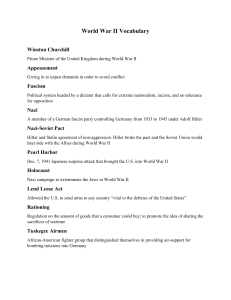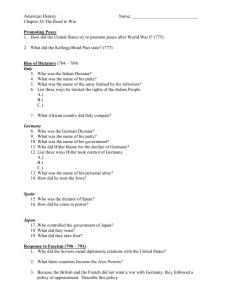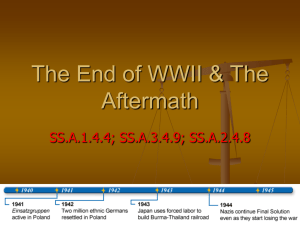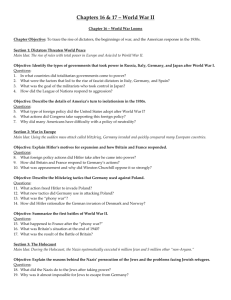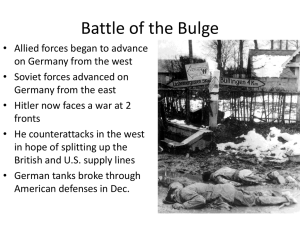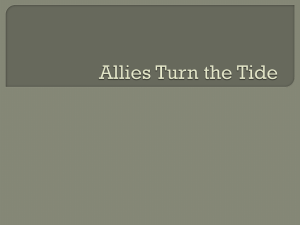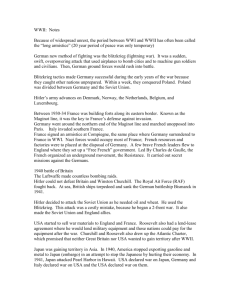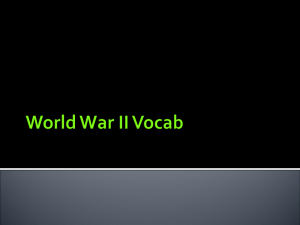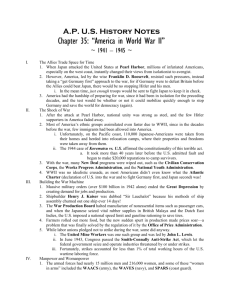File - AP US History
advertisement
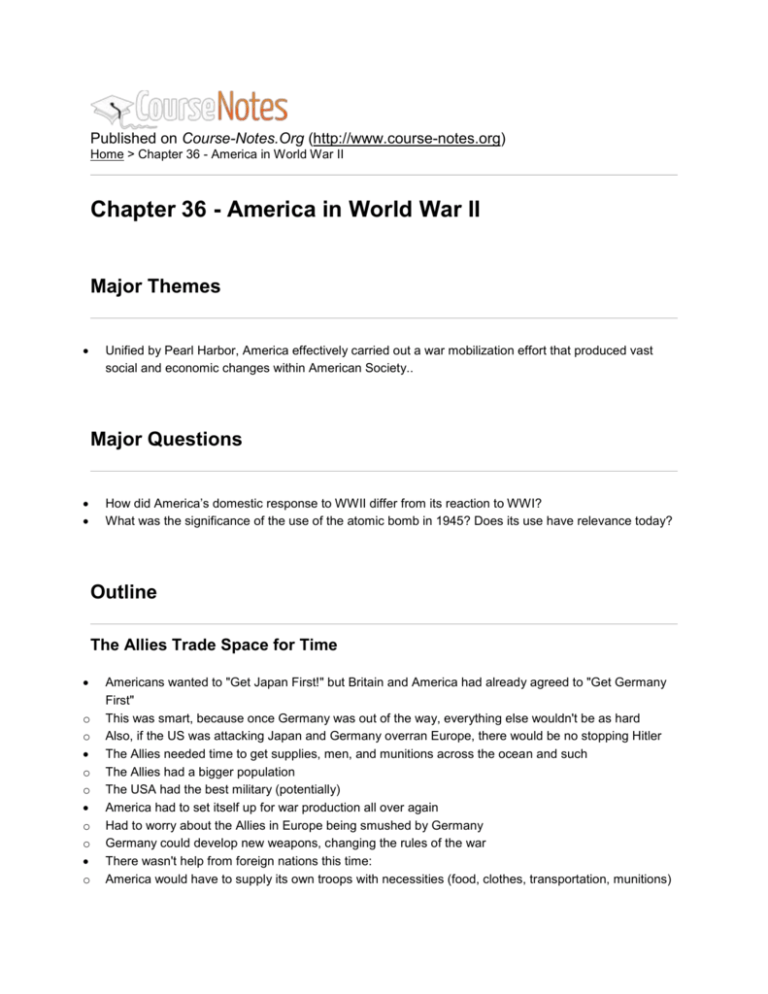
Published on Course-Notes.Org (http://www.course-notes.org) Home > Chapter 36 - America in World War II Chapter 36 - America in World War II Major Themes Unified by Pearl Harbor, America effectively carried out a war mobilization effort that produced vast social and economic changes within American Society.. Major Questions How did America’s domestic response to WWII differ from its reaction to WWI? What was the significance of the use of the atomic bomb in 1945? Does its use have relevance today? Outline The Allies Trade Space for Time o o o o o o o Americans wanted to "Get Japan First!" but Britain and America had already agreed to "Get Germany First" This was smart, because once Germany was out of the way, everything else wouldn't be as hard Also, if the US was attacking Japan and Germany overran Europe, there would be no stopping Hitler The Allies needed time to get supplies, men, and munitions across the ocean and such The Allies had a bigger population The USA had the best military (potentially) America had to set itself up for war production all over again Had to worry about the Allies in Europe being smushed by Germany Germany could develop new weapons, changing the rules of the war There wasn't help from foreign nations this time: America would have to supply its own troops with necessities (food, clothes, transportation, munitions) It also had to give all of this stuff to its Allies The Shock of War o o o o o o America was completely unified this time around Communists in America had disagreed with the sar, but after Germany turned around on USSR, they wanted total war against the Axis Powers Immigrants (Italian-Americans, German-Americans) supported America The Immigration Limits had helped these groups assimilate, so there was less worry about Hyphen Americans The exception was Japanese-Americans There was a history of Japanese immigrant hatred, and it flared during the war About 110,000 J-A's were put in "internment camps" which was a fancy way of saying concentration camps 2/3 were American born citizens There was a wide-spread fear that the J-A's would spy for their home country Supreme Court upheld the Internment Camps in the Korematsu v. U.S. (later apologized and paid $20,000 to each survivor) The "new" Conservative Congress killed lots of New Deal Programs (CCC, WPA...) The New Deal was done and the new goal was to Win the War The government made a little propoganda, ubt mostly focused on action (lack of time) 9/10 Americans didn't know any of the Atlantic Charter A majority didn't know what the war was about All the same, America pushed hard and got down to work They were mondo-efficient Building the War Machine o o o o The economy was healed by the War About $100 billion in military orders was made in 1942 This took up the overproduction of the G.Depression War Production Board was created and American Factories made: 40 billion bullets 300,000 aircraft 76,000 ships 86,000 tanks 2.6 million machine guns Henry J. Kaiser (strange the people would trust that last name in a time like this, but put the Japanese in camps...) Sir Launchalot made tons of ships The WPB stopped production of nonessential things (passenger cars) o o o o o Made a priority idea When natural rubber supplies died, it made 51 synthetic rubber plants Farmers also increased output (gotta feed the hungry and all that) They had less workers, but better fertilizers and machines allowed for increased output There were also economic strains 1942 saw serious inflation The Office of Price Administration made regulations to stop the upward climb of prices There was rationing (butter, meat...) but there was black markets that killed these ideas a little bit The WLB made "ceilings" on wages Labor Unions got angry about the wage-ceilings Membership went from 10 mill. to 13 mill. There were many violations of the no-strike pledges United Mine Workers (led by John L. Lewis) were especially prominent The government was concerned that strikes would lower production and therefore jeopardize victory hence: Passed the Smith-Connally Anti-Strike Act Government could take over "tied-up" industries Strikes against gov't owned industries were illegalized Gov't took over the mines and RRs for a little while Despite the strikes, American workers in general put out a great effort Manpower and Womanpower The armed services enlisted nearly 15 million men in World War II and some 216,000 women who were employed for noncombat duties. Best known of these "women in arms" were the WAACs (army), WAVES (navy), SPARs (coast guard) The US exempted certain key categories of industrial and agricultural workers from the draft in order to keep its mighty industrial and food-producing machines humming. But even with these exemptions thedraft left the nation's farms and factories so short of personnel that new workers had to be found. An agreement with Mexico brought thousands of Mexican agricultural workers across the borderto harvest the fruit and grain crops of the West. More than 6 million women took up jobs outside the home, over half of them had never before worked for wages. Many were mothers and the gov't was obliged to set up some 3,000 day-care centers to care for their children. The war foreshadowed an eventual revolution in the roles of women in American society. The war's immediate impact on women's lives has frequently been exaggerated. the great majority of American women did not work for wages in the wartime economy but continued in their traditional role. In Bri. and the Soviet Union a far greater percentage of women, including mothers were pressed into industrial employment. A poll in 1943 revealed that a majority of American women would not take a job in a war plant if it were offered. o At the end of the war two-thirds of women war workers left the labor force. Many were forced out of their jobs by employers and unions eager to re-employ returning servicemen. Wartime Migrations o During the war many people moved into boomtowns that had war industries about 1.6 million blacks migrated west and north leaving the south to seek war jobs After this migration race became a national issue In 1941 Roosevelt issued an executive order forbidding discrimination in the armed forces After the war millions more blacks migrated north The war also brought about an exodus of the Native Americans from reservations to cities Several native americans also served in the armed forces A few race riots occurred in various cities caused by the influx of new people Holding the Home Front o o o o o o o o o o o o Americans were the lucky few who saw no action on the home front the war boosted our economy & brought us out of the Great Depression businesses greatly benefitted from the war, doubling product $$ in 5 yrs income increased despite wartime taxes resulting in price controls being lifted (1946) & Am. consumerism raising prices to 33% in < 2 yrs Europe struggled along due to the damages of war the war ushered in major gov't interventionism the rationing system ppl working for the armed forces ppl working for the defense industries (employers & unions monitered by FEPC& WLB) ppl's need cared for by gov't-sponsered: housing projects day-care centers health plans Office of Scientific Research and Development gov't & universites working together for scientific research, foreshadowing Am's technological & economic leadership in the postwar era 1941-1945 are looked back as the origins of a "warfare-welfare state" WWII war costs: $330 billion 10x more than WWI twice as much as ALL federal spending since 1776 income-tax net expanded to include 4x more ppl max. tax rates rose as high as 90% 2/5ths war costs paid from current revenues, the rest was borrowed o o Nation debt 1941: $49 billion; 1945: $259 billion once production started running, the war cost $10 million per hour! The Rising Sun in the Pacific o o o o o o o Japanese militarists realized they had to win quickly or lose slowly At the same time as the attack on Pearl Harbor, the Japanese launched other assaults on various Far Eastern places inluding: U.S. outposts of Guam, Wake, & the Philippines Hong Kong (British-Chinese port) & British Malaya Burma-the U.S. was was trucking munitions over the Burma Rd. to a Chinese army under Jiang Jieshi Dutch East Indies (oil-rich) The Philippines succeeded in slowing down the Japanese mikado's warriors for 5 months The Japanese then landed a small & effective army Gen. MacArthur w/drew to Bataan to be on the defense there 20,000+/- US troops & a bigger force of untrained Filipinos held off Jap. attacks until April 4, 1942 Before the US surrendered, MacArthur, w/ orders from Washington, secretly left Australia to head the resistance against the Japanese After surrendering, the remaining army was treated terribly in the 80-mile Bataan Death March to POW camps Corregidor(an island fort in Manila Harbor) held out until May 6, 1942 it then surrendered to the Japanese giving the complete control of the Philippine archipelago to Japan Japan's High Tide at Midway o o o o o o o o o The Japanese pushed southward They invaded New Guinea, north of Australia, & landed on the Solomon Islands May 1942, Japanese onrush was checked by a naval battle fought in the Coral Sea a US carrier task force w/ Aussie support=heavy losses for Japan for the 1st time ever, fighting was done completely by carrier-based aircraft, neither side fired directly at one another Then, Japan decided to seize Midway Island 1,000+ miles northwest of Honolulu Could attack Pearl Harbor more Hoped to negotiate a cease-fire in the Pacific with USA Battle of Midway: June 3-6, 1942 Americans led by Admiral Chester W. Nimitz Used a smaller fleet than the Japanese, but the Japanese lost 4 major carriers and retreated Midway and Coral Sea were important US had halted the Japanese However, Japan took over Kiska and Attu (islands near Alaska) o Americans sent troops to defend Alaska Japanese were overextended, and so it was easier to dislodge them later on The Allied Halting of Hitler o o o o o o o o o Hitler entered the war with a fleet of ultramodern subs Ship destruction far outran ship construction for Allies Was a hard and slow battle turning the tides in subsea war Tactics were strengthened by the use of air patrol and radar Allied submarine tactics improved greatly when Britain broke the German code Allowed the Allies to pinpoint German U-Boats In the spring of 1943 the Allies first gained an advantage over the U-Boats The Battle of the Atlantic was close, but the Allies won The turning point for the land-air war had come late in 1942 The British were joined by the Americans in August 1942 and bombed many German cities In late October the Germans were pushed back to Tunisia On the Soviet front, the red army gave the Allies a new lift In Sept. 1942, the Russians stalled the Germans at Stalingrad The Russians launched a resiliant attack and never let up Stalin had regained about 2/3 of the Soviet land that Hitler had taken A Second Front from North Africa to Rome o o o Soviet losses in 1942 were terrible millions had already died The soviets wanted the allies to open a new front to give them cut them some slack The Americans wanted to assault Frances coastline Britain thought that would fail so the allies postponed an invasion of Europe They did start a new front though in November 1942 about 400000 men invaded North Africa which they took finally in may 1943 Roosevelt and Churchill meeting in Morocco decided to issue the terms of unconditional surrender This move was partly to appease the soviets who still wanted a larger second front The allies soon after took Sicily in August 1943 Italy also surrender around this time However hitlers troops were still in Italy and they fought bitterly against the allies The allies stalled out for many months in Italy and after D day it became a sort of sideline war D-Day: June 6, 1944 The Soviets had constantly pused for a second front agains Germany o o o o o FDR, Stalin, and Curchill agreed to meet in Iran they agreed on a two front assault on Germany Elaborate plans were made for an invasion of Normandy The assault was to be sent from England millions of primarily American soldiors as well was munitions flooded the island General Eisenhower was selected to be in charge of the assault French normandy was chosen due to its reletively weak german defenses(still very strong) allies already had control over the air and prevented reinforcement a feint made Germans think the attack woiuld be farther north the allies at first secured only a small beachead, but quickly spread on a relentless assualt twoard Germany FDR: The Fourth-Termite of 1944 o o o o o the Presidential Campaign of 1944 couldn't have come at a worse time i.e. the climax of the war Repubs nominated Thomas E. Dewey, the 42 yr old, short, liberal, "mustachioed", dapper, NYC prosecuter of grafters & racheteers from New York he wan't very worldly so the convention nominated isolationist Senator John W. Bricker of Ohio for Vice President platform: prosecution of the war & creation of new international peace organization Dems obviously nominated FDR, the "indispensible man" of the Dems He was oddly forgotten & lots of attention was forcused on the Vice President nominee [lucky for FDR] Henry A. Wallace, secretary of agriculture, desired a renomination but conservative Dems saw him as ill-balanced & an unpredictable liberal major "ditch Wallace" campaign emerged nomination went to smiling Harry S. Truman of Missouri had recently conducted and investigation of wasteful war espenditures as the chairman of the Senate Commitee conducting that investigation no one had much against him or on him Roosevelt Defeats Dewey o o Dewey took the offensive because Roosevelt was too busy directing the war Republicans feared the "lifer" in the White House In the closing weeks Roosevelt left his desk finally Roosevelt won 432 to 99 in the Electoral college 25,606,585 to 22,014,745 in the pop vote Roosevelt won primarily because the war was going well Foreign policy was also a decisive factor in the winning of FDR Experience again played a role in the election of FDR The Last Days of Hitler o o o o o o In mid-December the Third Reich was crumbling, allied bombers had decimated almost all German factories and cities and the Western Allies were striking repeated heavy blows At one last bid for the survival of Nazi Germany, Hitler through all of his reserves ( which he had been secretly building up) at the Western Allies on December 16th, 1944 struck in the Ardennes Forest with the hope of reaching and capturing the key Allied supply point of Antwerp, Belgian (a port) somehow caught the Allies (mostly Americans) off guard and drove them back the ten day penetration was finally stopped after the 101st Airborne Division had held their ground at Bastogne In March 1945, the Americans reached the Rhine River where by incredibly good luck, they found one key bridge undemolished soon reached the Elbe River in April and met up with their Soviet comrades Found concentration camps where the Jews had been killed the Washington Government had known about Hitler's campaign of genocide, but did not know how serious it was Soviets reached Berlin in April 1945 pillage and rape After marrying his long time mistress (Eva Braun), Hitler commited suicied on April 30th Roosevelt died in Georgia on April 12th V-E (Victory in Europe) Day on May 7th, 1945 The Atomic Bombs o o o o o o o o o o Strategists had been planning the invasion of the Japanese homeland it was expected to cost hundreds of thousands of American lives (and many more Japanese) Japan still wouldn't surrender unconditionally and had no outward intention to Potsdam Conference gave Japan an ultimatum: surrender or be destroyed warning was showered over Japan by bombers America had the a-bomb had made it due to Einstein's pleas that America make one before the Germans did Germany had lost before it got used, Japan became the next target first a-bomb tested in the desert near Alamogordo, New Mexico on July 16th, 1945 A-bomb used on Hiroshima first on August 6th, 1945 180,000 died, 70,000 instantly Japan would not yield, so on August 9th a second a-bomb was used on Nagasaki 80,000 died instantly Japan finally surrendered on August 10th, 1945 under the condition that their Son of Heaven, Hirohito, remained on the throne allies accepted on August 14th official surrender on September 2nd, 1945 ceremonies conducted by General MacArthur on the battleship Missouri in Tokyo Bay V-J Day celebrated at home The Allies Triumphant o o o America suffered nearly a million casualties reduced greatly by advances in health care America was one of the few nations not utterly destroyed by the war Americans became known as the military power of the world Won primarily through miricles of industry America simply had more supplies Subject: US History [1] Subject X2: US History [1] Source URL: http://www.coursenotes.org/US_History/Notes/The_American_Pageant_12th_Edition_Textbook_Notes/Ch apter_36_America_in_World_War_II Links: [1] http://www.course-notes.org/Subject/SocialScience/US_History
